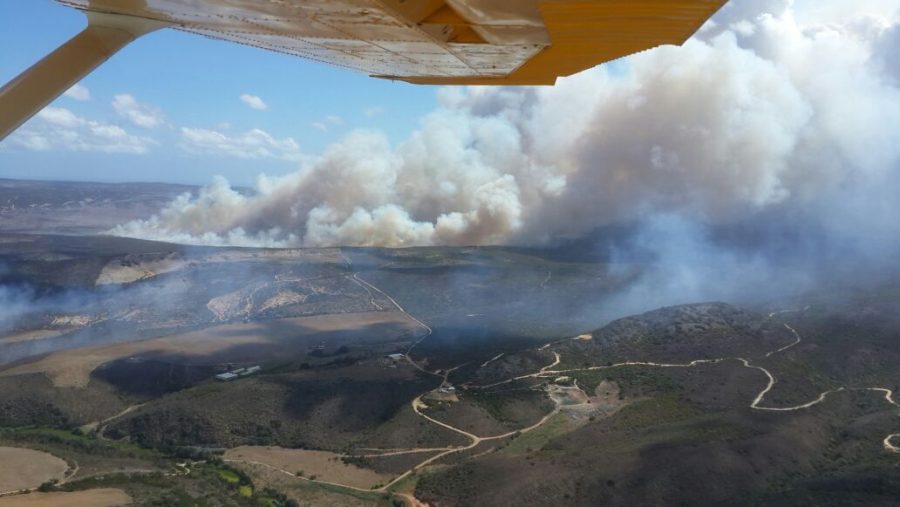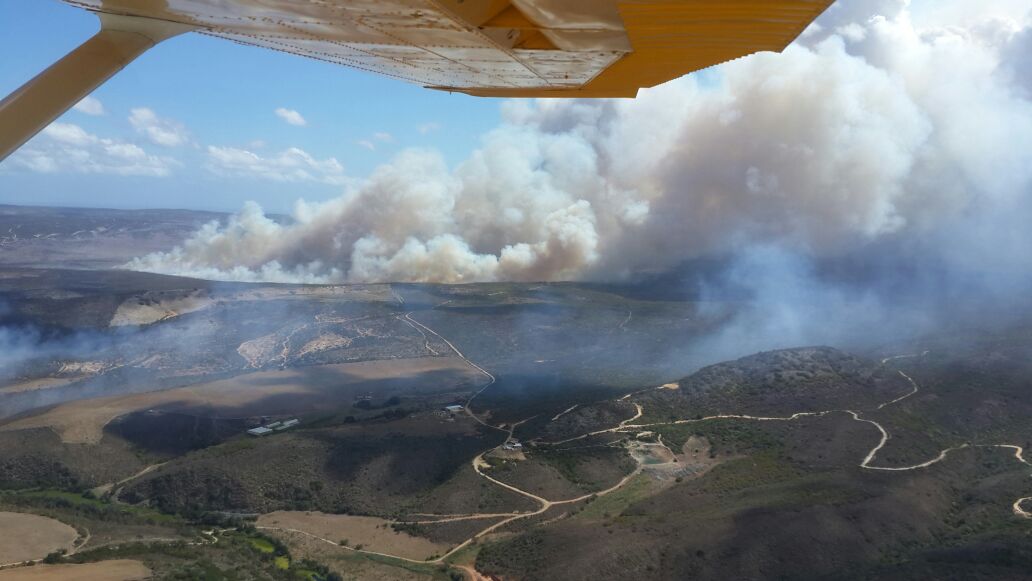
Stilbaai Fire Declared Local Disaster and Fire Warning. Facts, Figures, Update on the 2017 Cape Fires
The Stilbaai Fire (Still Bay) in the Western Cape, South Africa, has been declared a local disaster after three farm houses have been destroyed, and multiple farm houses evacuated since Tuesday evening. According to a Working on Fire facebook update this afternoon, the Incident Commander says that yesterday evening all efforts were put in to […]

The Stilbaai Fire (Still Bay) in the Western Cape, South Africa, has been declared a local disaster after three farm houses have been destroyed, and multiple farm houses evacuated since Tuesday evening.
According to a Working on Fire facebook update this afternoon, the Incident Commander says that yesterday evening all efforts were put in to control the fire. “Unfortunately the strong Easterly winds of approximately 40kms per hour caused the fire to burn out of control.”
Approximately 130 personnel are on the scene including two 802 air tractor bombers, two Huey Helicopters and a spotter plane.
A Joint Operating Center has been established for this fire. JOC includes the Eden and Hessequa Municipality, Provincial Disaster Management Centre and Working on Fire.
The Du Toitskloof Fire is also ongoing… now in its third day. See video below. And a fire in Franschhoek has flared up this afternoon.
Cape Town City officials have issued a fresh fire warning as extremely hot, dry and windy conditions persist in the Western Cape.
The latest update on the multiple fires that are burning across the Western Cape is as follows (as supplied by Working on Fire):
- The fires are still burning. There were ten fires yesterday (five in the Southern Cape and five in the Western Cape), six of which were contained.
- High temperatures, no rain and especially windy conditions are the forecasts for the rest of the month, so it appears the fires will continue.
- February is a very dry month (2% of our annual rainfall)
- In those areas where they have been contained ground teams have begun with mop-up operations.
- The contingent of firefighters from the Department of Environmental Affairs’ Working on Fire (WoF) programme played an instrumental role in assisting Cape Nature and disaster management officials in containing the fires.
- The fire crews, bolstered by aerial support, were busy at multiple fires in Somerset West, Simons Town, Tulbagh and Grabouw in the Western Cape.
- Over 1000 firefighters were deployed– with some mobilized from as far afield as bases in the Eastern Cape and Free State.
- They were supported by a Working on Fire spotter plane, fixed wing air tractor bomber and a helicopter.
- Working on Fire programme spends about R80 million per year in the Western Cape, preventing and managing large wild fires.
- We have 25 helicopters, fixed-wing bombers and spotter planes, and 36 pilots, based in the Western Cape and about 70 vehicles that provide logistical and fire-fighting support.
- Working on Fire (WoF) falls under the Department’s Environmental Programmes and is implemented through the Expanded Public Works Programme (EPWP).
- Unemployed young men and women are trained in various fire management and suppression skills including but not limited to firefighters, drivers, brush cutters, dispatchers, helicopter safety leaders and environmental educators.
- Since the start of the fire season (1 December 2016) ground and aerial support have been instrumental in the suppression of 57 fires and limited the areas burnt by 95 959.3 hectares throughout the Western Cape. Firefighting aircraft have racked up 432.3 flying hours.
- For January 2017 alone, ground and aerial support were instrumental in the suppression of 53 fires and limited the areas burnt by an impressive 31 000 hectares throughout the Western Cape. Firefighting aircraft racked up more than 300 flying hours.
Day 3 – Du Toitskloof fire still ongoing & WOF firefighters still on the fire line.#DuToitskloofFire @News24 @IOL @SABCTVNews @ewnupdates pic.twitter.com/nJ8tPMlhTq
— Working on Fire (@wo_fire) January 18, 2017
STILBAAI FIRE DECLARED A LOCAL DISASTER
Three farm houses has been destroyedhttps://t.co/kzKwu1B1un#SavingLives #ProtectingTheEnvironment pic.twitter.com/OYSf3kwUzP— Working on Fire (@wo_fire) January 18, 2017
A Picture taken from spotter Aircraft of the #StilbaaiFire via @wo_fire pic.twitter.com/yg2VKOBh9k
— AlgoaFMNews (@AlgoaFMNews) January 18, 2017
…and yet another #wildfire 🔥flaring up in the Western Cape, this time in #Franschhoek. pic.twitter.com/Z9etvbAFMO
— Herman Lintvelt (@winetourismza) January 18, 2017